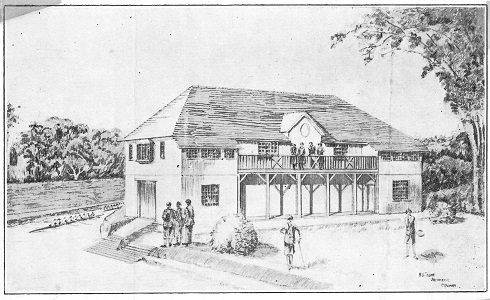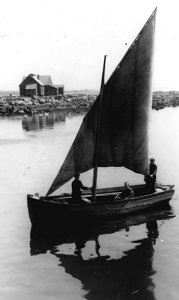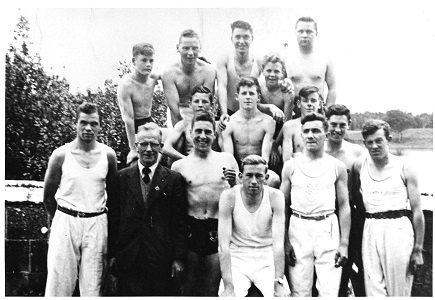Old Galway
THE ROYAL GALWAY YACHT CLUB

by Tom Kenny
Our first illustration today is a drawing by M.J. Tighe, architect, Galway, of the proposed new clubhouse for the Royal Galway Yacht Club at the corner of the Gaol River and the Eglinton Canal. The club was founded and received Royal Warrant in 1882. It was established as a social combination to promote sailing and rowing on the bay and lake, and the enjoyment of all the amenities of the Corrib Lake and River. They managed to survive and carry on for some years in difficult circumstances.
The club premises was in a good position occupying about three roods. It had a long term lease expiring in 2002 at an annual rent of £10. It had recently been enhanced by the provision of a hard court for lawn tennis.
THE GALWAY WORKHOUSE

by Tom Kenny
The first formal meeting of the Board of Guardians of the Galway workhouse took place in the Town Hall on July 3rd, 1839, and the building opened on March 2nd, 1842, one of many such workhouses built around the country. On March 16th, the first pauper died from old age and destitution. The numbers of inmates gradually increased to 313 by May 1845, after which the Famine made a huge impact on the project. It was originally designed for 800 destitute persons but this quickly increased to 1,000. Included in the complex was an infirmary for sick paupers but this rapidly became the hospital for the city’s poor.
At the roadside was a large cut-stone entrance lodge which comprised of a boardroom, clerk’s office, porter’s room, waiting area and probationary wards for paupers, males on one side, females on the other. Our photograph of this lodge was taken from the road by Fr. James Mitchell in 1956, just before the building was demolished.
THE GALWAY ISOLATION HOSPITAL

by Tom Kenny
The possible introduction of cholera and smallpox from abroad concerned the Government and so the Cholera Act of 1893 empowered sanitary authorities to enter lands for the construction of isolation hospitals
The Galway Port sanitary Authority was set up to manage Public Health matters in Galway Port, most especially to prevent infectious diseases that might be brought ashore from ships entering the port. The board consisted of 17 members elected from component local authorities and their jurisdiction extended from Golam Head in County Galway to Hag’s Head in County Clare together with the waters of Galway Bay.
In 1895, the board constructed a temporary building at Renmore Point on land owned by the Governors of Erasmus Smith Schools but leased to a Major John Wilson. In 1906, they wished to construct a permanent hospital there and a more formal lease was negotiated for 2 acres on the point just opposite the docks, with appropriate rights of way across the land. The lease was for 40 years at a nominal rental of £1 per annum.
Kirwan’s Lane, a bird’s eye view

by Tom Kenny
This lane is one of the most attractive in Galway and one of the most historic. There were originally 14 lanes in medieval Galway and this is one of the few that still exist. It dates back to the 16th century. As our photograph shows, it must have been very impressive back then.
It is considered by historians and archaeologists to be one of the richest areas “in terms of its medieval layout, building design and street plan”. It evidently received its name from the Kirwan family, one of just two of the ‘tribes’ who were of Gaelic origin. They were successful merchants and landowners who moved into the city around 1490, and whose wealth helped Galway reach the peak of its splendour during the 16th and 17th centuries.
GEORGE CHAMBERS’ PHOTOGRAPHIC ARCHIVE

by Tom Kenny
George Chambers was born in England in 1873. He lived at Temple Fortune Lane in Middlesex. He travelled extensively and this included several trips to Ireland. In 1929, he toured parts of West Cork and Wicklow, in 1931, he visited Galway City and the Aran Islands and on subsequent trips he went to the Blasket Islands, to Achill and Clare Islands and to various other islands off the coast of Donegal.
Happily, he brought his camera with him and left a visual record of these tours. Sadly, only two of his images of Galway City survive and one of those photographs we have for you today. It is titled ‘Penelope and Katrina’ and shows two ladies, obviously known to the photographer, walking across Dominick Street Bridge with their bicycles. The second city image is just of George standing with his back to the railings of the bridge with the Eglinton Canal behind him.
REMEMBERING ‘WILLIAMEEN’ MCDONAGH

by Tom Kenny
We have two photographs today of groups from Our Lady’s Boys Club. Firstly, a club rugby team that made history by winning the Connacht Junior League for the first time in 1959 and secondly, some Club members taken on the annual camp in Lough Cutra Castle, c.1956.
The rugby team is, back row; Michael Crean, Tony Maher, Tommy McDonagh, Michael Cunningham, John O’Shaughnessy, Des O’Shaughnessy, Michael O’Shaughnessy, Tom Cunningham and Des Kenny. In front are Aidan McCaffrey, Paddy McDonagh, William McDonagh, Paddy Beatty (captain), Brod King, Eamonn Griffin, Joe Geoghegan and Jim Cunningham.
The Lough Cutra group are, front row; Paddy McDonagh, Jim Cunningham, Fr. Michael McGrath SJ, Michael Darcy, William McDonagh. 2nd row; Michael Burke, Leo Crean, Des Fitzpatrick, Seanie Flaherty, Peter Griffin, Michael Carrick, Patsy Burke. At the back are Tommy Cunningham and Joe Geoghegan.
JOE YOUNG’S AERATED WATERS

by Tom Kenny
Joseph Young was appointed manager of Messrs. Thomas Tracey’s Mineral Water works and Licensed Premises in Mary Street after the death of Thomas Tracey. He later married the niece of Mrs.Tracey, (Miss Edith O’Connor of Clifden) and Mrs. Tracey signed over the works to Joe Young on the marriage.
Hardiman, in his 1820 history of Galway, wrote about a well that was reputedly 1,000 years old, described as a “Chalybeate spring of the same class as the celebrated Scarborough Waters, outside the East Gate was in great repute here. A spa house has been erected over it by a Mr. Eyre and is much frequented”. Hardiman attributed the numerous instances of longevity in the area to the tonic quality of the water in this well.
THE CORRIB ROWING AND YACHTING CLUB

by Tom Kenny
This club, originally established in 1864, must be one of the oldest in Galway, if not one of the oldest amateur sporting clubs in the country. Unfortunately, the minutes of the club meetings for 1864 and 1865 cannot be found, but we are fortunate that Maurice Semple had access to the minutes for most other years and published them in a book entitled A Century of Minutes, the Story of the Corrib Club, 1864 – 1966.
The inauguration of the club took the form of ‘a rowing match’ between W. and P. Daly in one boat and a Mr. Hasler and Robert Evans in the other. ‘A respectable assemblage thronged the banks on either side and all present seemed very much interested in the contest’. The clubhouse was already in existence and on that inaugural day, a large number of young gentlemen of Galway gathered there for the occasion. Their first meeting was a success and the committee felt confident that the members would find “The manly sport of rowing to be both pleasurable and profitable”.
